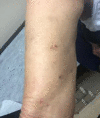Atypical Bullous Pemphigoid After Linagliptin Intake
- PMID: 34584063
- PMCID: PMC8488187
- DOI: 10.12659/AJCR.932356
Atypical Bullous Pemphigoid After Linagliptin Intake
Abstract
BACKGROUND Bullous pemphigoid is a common pruritic skin lesion reported in elderly patients. It is caused by an immunologic reaction between autoantibodies and hemidesmosome proteins of epithelial cells. The disease is characterized by a symmetrical blister distribution on the body. Diagnosis should be suspected in elderly patients presenting with a tense blister on normal-appearing skin or on an erythematous base. In the literature, several forms of typical bullous pemphigoid after treatment with linagliptin have been reported. However, this is the first reported case of atypical nonbullous pemphigoid after linagliptin intake. CASE REPORT A 77-year-old woman presented with multiple erythematous papules and nodules on the upper extremities and trunk. The patient was being treated with linagliptin for diabetes. Diagnosis was made with biopsy and histopathological studies, followed by direct immunofluorescence. The histopathological study showed a subepidermal blister with an underlying polymorphous infiltrate, mainly of an eosinophilic profile. Direct immunofluorescence showed linear IgG and C3 antibodies to hemidesmosomes at the lamina lucida of the basement membrane. Thus, the diagnosis of atypical nonbullous pemphigoid was made. CONCLUSIONS This report emphasizes the great variety of bullous pemphigoid presentation and the need for a greater level of awareness of the adverse effects of linagliptin. Thus, atypical nonbullous pemphigoid should be considered among the potential differential diagnoses in patients with multiple erythematous papules and nodules on the upper extremities and trunk.
Conflict of interest statement
Figures
References
-
- Garcia-Diez I, Ivars-Lleo M, Lopez-Aventin D, et al. Bullous pemphigoid induced by dipeptidyl peptidase-4 inhibitors. Eight cases with clinical and immunological characterization. Int J Dermatol. 2018;57(7):810–16. - PubMed
-
- Di Zenzo G, Della Torre R, Zambruno G, Borradori L. Bullous pemphigoid: From the clinic to the bench. Clin Dermatol. 2012;30(1):3–16. - PubMed
-
- Cozzani E, Gasparini G, Burlando M, et al. Atypical presentations of bullous pemphigoid: Clinical and immunopathological aspects. Autoimmun Rev. 2015;14(5):438–45. - PubMed
-
- Rawson K, Vinod S, Sreenivasan B, Roy G. Drug-induced bullous pemphigoid – a case report with review. J Indian Acad Oral Med Radiol. 2018;30(4):427–31.
-
- Korman N. Bullous pemphigoid. J Am Acad Dermatol. 1987;16(5 Pt 1):907–24. - PubMed
Publication types
MeSH terms
Substances
LinkOut - more resources
Full Text Sources
Medical
Miscellaneous




